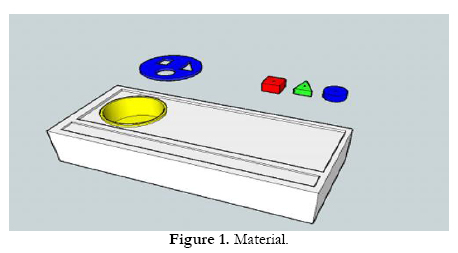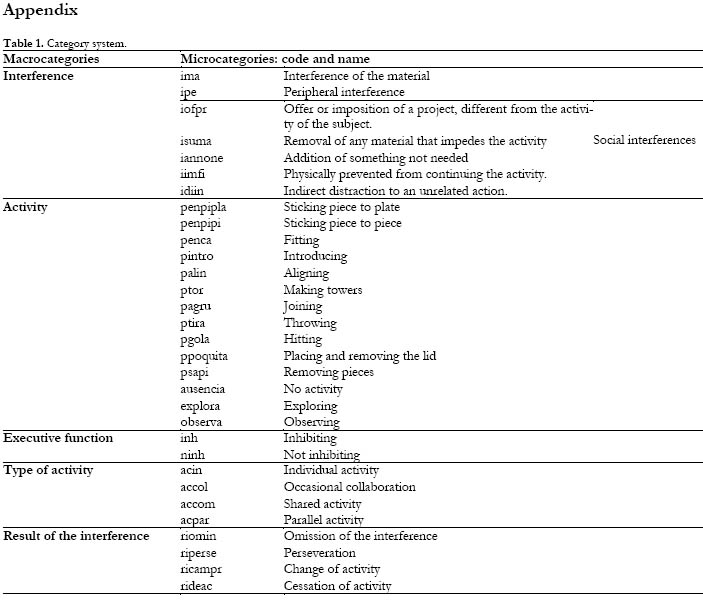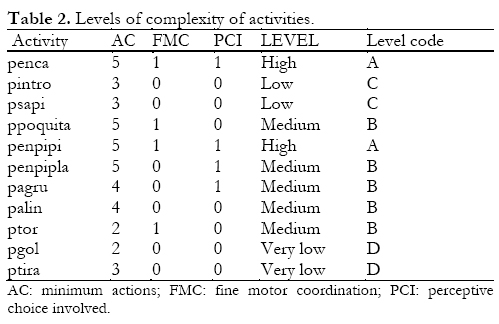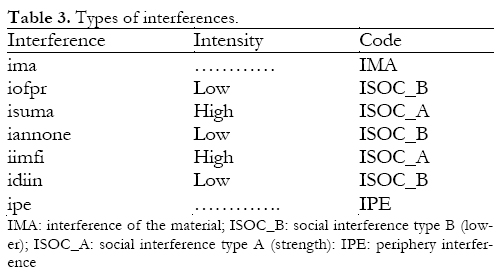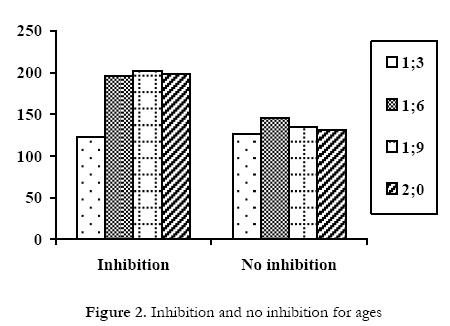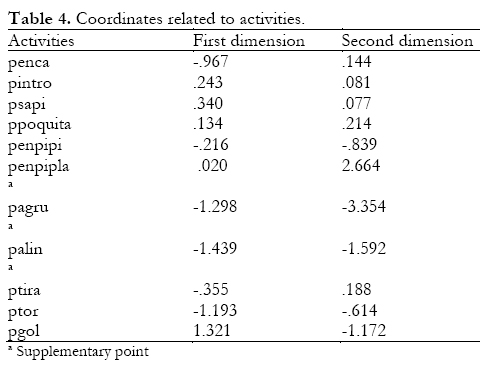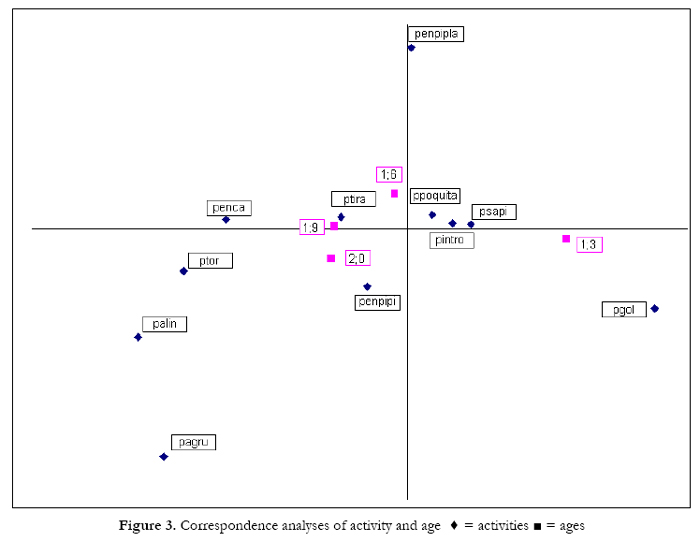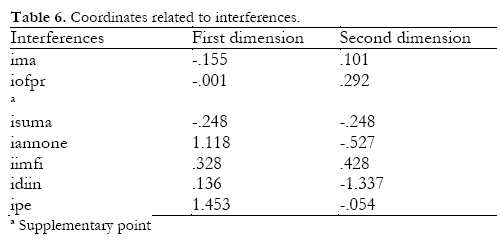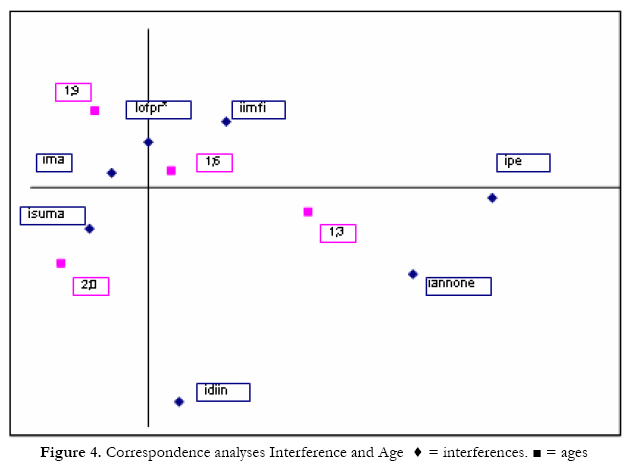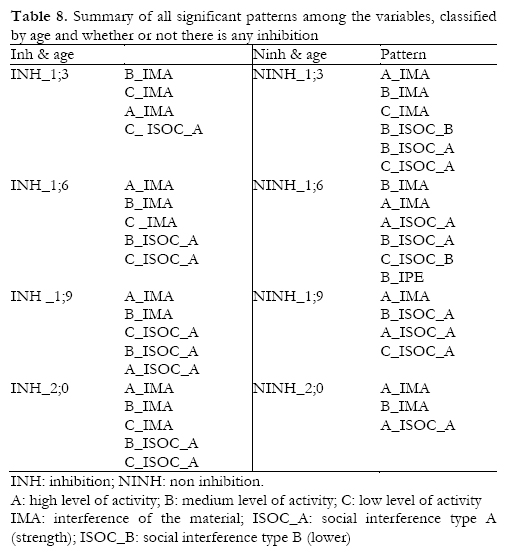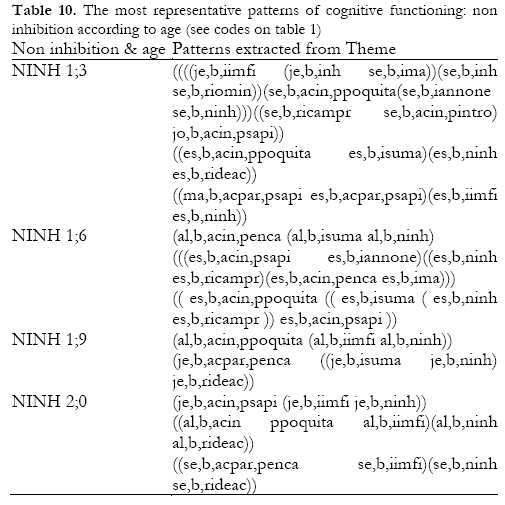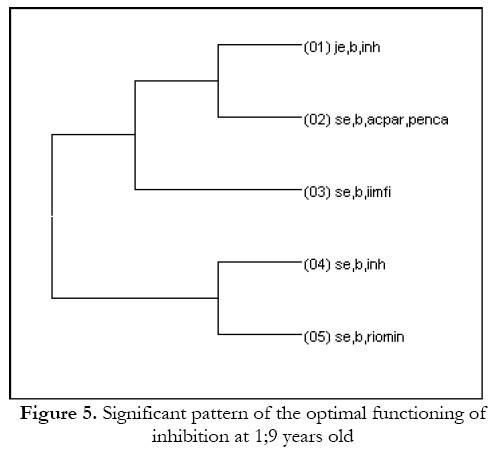My SciELO
Services on Demand
Journal
Article
Indicators
-
 Cited by SciELO
Cited by SciELO -
 Access statistics
Access statistics
Related links
-
 Cited by Google
Cited by Google -
 Similars in
SciELO
Similars in
SciELO -
 Similars in Google
Similars in Google
Share
Anales de Psicología
On-line version ISSN 1695-2294Print version ISSN 0212-9728
Anal. Psicol. vol.31 n.2 Murcia May. 2015
https://dx.doi.org/10.6018/analesps.31.2.159121
The ability to manage self-proposed projects between 1;3 and 2;0 years old: a study of inhibition and resistance to interference
La capacidad de gestionar proyectos propios entre los 1 y 3 años de edad: un estudio de la inhibición y la resistencia a la interferencia
Estanislao Pastor-Mallol and Edith Santó-Rañé
Universidad "Rovira i Virgili", Tarragona (Spain).
ABSTRACT
This study examines very young children's ability to manage self-proposed projects by using the inhibitory function and resistance to interference. In a natural environment and using an observational method, we conducted a longitudinal study of a sample observed at 1;3, 1;6, 1;9 and 2;0 years old. The research was divided into two studies which followed different procedures and looked at the projects carried out, the interferences produced and the functioning of inhibition. We observed significant differences in the execution of inhibition at the different age groups. We also describe general cognitive functions in terms of significant patterns, and determine that the use of inhibition is linked not only to age but also to the activity complexity level and the type of interference.
Key words: Executive functions; inhibition; interference; cognitive development; early ages.
RESUMEN
Este estudio examina la capacidad de mantener proyectos propios basándose en la ejecución de la función inhibitoria desde la perspectiva de la "Resistencia a la Interferencia". En un contexto ecológico y siguiendo la metodología observacional, conducimos un estudio longitudinal con una muestra observada a los 1;3, 1;6, 1;9 y 2;0 años de edad. La investigación se ha dividido en dos estudios, con diferentes procedimientos de análisis y considerando los proyectos que se llevan a cabo, las interferencias que se producen y la función de inhibición. Hemos observado diferencias significativas en la ejecución de la inhibición de acuerdo con las edades estudiadas. También describimos el funcionamiento cognitivo general, con patrones de conducta significativos, determinando que el uso de la inhibición esta relacionado no solo con la edad sino también con el nivel de complejidad de las actividades y el tipo de interferencias.
Palabras clave: Funciones ejecutivas; inhibición; interferencia; desarrollo cognitivo; edades tempranas.
Introduction
The topic of this study cannot be investigated without mentioning the ability of subjects to generate projects at a very early age. Since the arrival of the new functionalism with its constructivistinteractionist orientation (Beilin, 1987), the subject has been conceived as an asset and self-regulator from birth. The subject perceives, gives meaning and relational structure to objects, events and other people in order to operate with them (Pastor & Sastre, 1994). Construction happens to be an essential issue in development, and so it is necessary to understand its mechanisms. The ability to carry out projects allows the child to generate increasingly elaborate plans.
The executive functions are the set of cognitive processes which use high-order skills to successfully resolve problems that arise in our daily lives. We have a set of skills involved in generating, monitoring, regulating, enforcing and adjusting behaviour so we can achieve complex objectives, especially those that require an innovative and creative approach (Gilbert & Burguess, 2008).
The term inhibition is used to describe an active process which prevents unwanted interference from irrelevant information (Dempster, 1992). At a basic level, inhibitory processes control knowledge content and processing activities, while restricting attention only to the relevant aspects of the environment and limiting processing to only those aspects that are necessary to carry the task out (Bjorklund & Harnishfeger, 1995). This aspect is key for adults and children in the acquisition and expression of cognitive abilities (Daurignac, Houdé & Jouvent, 2006). The literature describes several levels of inhibition. Inhibition mechanisms can be distinguished according to what psychological constructs they act on. Behavioural inhibition involves the control of overt behaviour, such as resisting temptation, delaying gratification, motor inhibition and impulse control (Mishel, Shoda & Rodriguez, 1989). Cognitive inhibition involves the control of cognitive contents or processes, for example the gating of irrelevant information from the working memory when memory processing (Harnishfeger & Brainerd, 1993). Some researchers suggest that both types of inhibition are related (Harnishfeger, 1995) because they indicate that children use cognitive inhibition to facilitate behavioural inhibition.
One of the theories that explain the inhibitory capacity is Frank N. Dempster's "Resistance to Interference" (1991, 1992, 1993). According to this theory, inhibition is a difficult-to-observe executive function and, therefore, it should be induced from the subject's motor behaviour, such as sensitivity or resistance. The interference is understood as a neutral stimulus that conflicts with the project being carried out. According to this theory, sensitivity to interference, that is, being aware of the presence of a stimulus that disturbs an on-going project, is crucial to being able to overcome the disturbing stimulus and keep the activity on-going.
Resistance to interference is central to understanding development. It also emphasizes that the ability to resist interference is a sign of maturity and effective cognition, as well as a skill that develops in line with neuroanatomical development. From this fact, we can say that the development of both inhibitive and executive functions is closely linked to the maturation of frontal lobes (Verdejo-Garcia & Bechara, 2010), specifically the prefrontal cortex (Fuster, 1989; Papazian, Alfonso & Luzondo, 2006). This cortex plays a key role in orchestrating the executive functions because it is the brain region that most is most effective at integration (Garcia-Molina et al., 2009).There is some disagreement about which specific regions are involved in inhibitory processes; however, overall it can be argued that inhibition processes are associated with the bilateral prefrontal areas and the posterior cortical regions and some subcortical structures (Tirapu, Muñoz & Paul, 2008).
Executive functions change during development (Zelazo et al., 2003) and can be observed at very early ages when behaviours suggesting that some of the skills that make up executive functions have begun their development, although this executive control is still fragile and precarious (Garcia-Molina et al., 2009). Executive functions start to develop between 5 and 7 months of age (Bell & Fox, 1992). As for inhibition, Diamond (1991) shows in their studies that around 12 months, children are able, for the first time, to inhibit dominant responses, that is, to resist the strong response of the moment. It is in this second half of the first year, when the first simple forms of inhibitory control emerge. Around the second year the presence of a greater ability to maintain and manipulate information in coordination with the inhibition of responses allows the child to impose a certain cognitive control over its behaviour (Garcia-Molina et al., 2009).
Investigating the executive functions at early ages requires making a major adjustment to the methodology (Blanco-Villaseñoor, Sastre-Riba & Escolano-Pérez, 2010). The most common experimental task used in the laboratory to measure inhibition is the "Stroop Colour-Word Interference Test", which was developed by Stroop in 1935 (Dempster, 1993). There is also a version for children known as the "Day-Night task" (Gerstad, Hong & Diamond, 1994), to test for children aged from 3 to 4 years who still have difficulties in inhibiting a dominant response. These tasks, therefore, are not useful for evaluating the inhibitory capacity at early ages. In the literature, other measures have been developed to suit the characteristics of children.
Piaget's A not B task (1954) is one of the tests that has caused most interest in research into the development of executive functions during the first years of life. Diamond (1985) reused it in his research and, according to that author, the children's difficulty in finding the correct object hidden behind the screen (screen B) lies in the inability to inhibit the tendency to repeat the first action (search in screen A) which has been successful previously. There are hypotheses that children younger than 12 months are extremely susceptible to interference generated by initial successful searches.
Berger (2004, 2010) uses a variant of the A not B task as a locomotion test. She tests the hypothesis that when the attentional resources of children are overburdened, there is a balance between cognition (the ability to inhibit) and action (the ability to complete a motor task). This results in perseverance, which is he failure of inhibition and the corresponding inappropriate response where the child repeats a dominant action. Their sample consists of children from 1;1 years old. The strategies used by the subjects, the difficulty and demands of the task and the characteristics of children (experts vs. inexperienced) are aspects that influence the result of the task and the degree of perseveration shown.
Studies by Sastre-Riba (2006, 2009) and Sastre-Riba & Escolano-Pérez (2010) focus on the executive competences of children at early ages by comparing typical babies with babies with special characteristics (premature babies, low birth weight babies, Down Syndrome babies). The results show that there are differences in the executive performance of children studied at 1;3 and 2;0 years old in that there is a trend towards greater efficiency and flexibility as age increases and that the ability to inhibit increases with age while perseveration declines (Sastre-Riba, 2006).
López Chivrall (2007) used a fitting task in which, at certain times, the child needs to implement inhibition. In this research, the sample consisted of children of 1;3, 1;6 and 1;9 years old. One of the results was a gradual improvement between 1;3 and 1;9 years old in the children's ability to solve the fitting task.
From the existing literature we propose to provide knowledge about the executive skills at early ages. These skills will be assessed by studying children's ability to manage projects by implementing inhibition, and by studying their resistance to interference, as described by Dempster. The context used in the research is key to relating the findings to the real world. Therefore, we wanted to place the subjects in a natural environment. This way the children would feel comfortable enough to test their skills and carry out self-proposed activities, thus allowing us to evaluate their executive functions using an observational methodology that was free from artificial constraints and protocols. We then carried out an inductive study to determine the children's ability to maintain self-proposed projects in a sample followed longitudinally at 1;3, 1;6, 1;9 and 2;0 years old. We did this by presenting the children material that required them to use the executive function of inhibition.
A project remains active based on its strength and soundness. Both of them are facts that we will deduce from the subject's ability to inhibit the interferences produced. By self-proposed project, we refer to the actions and decisions that the subject carried out with the encouragement and material and that are intentionally aimed at a goal.
In order to determine whether the children maintain the self-proposed projects, we needed to know beforehand if the inhibit function appeared at the chosen ages, if there is a link or not between the activities carried out and the age of the subject, and if there is any relation between interference and age. Study I will answer these initial questions.
In Study II, we look at significant patterns in the real performance of the sample in order to determine general cognitive functioning by age thus establish:
- If the executive function of inhibition is present at the ages studied.
- If certain types of interference can or cannot be overcome (i.e. inhibited or not) by the subject, and at which ages.
- If the complexity of the activity affects or not the use of inhibition, and whether it has any relation with age.
- If the self-proposed projects in these age groups are sound or not.
Method
Participants
The sample used in this study comprises 12 subjects (N = 12), 6 girls and 6 boys, and was divided into 6 pairs, regardless of gender. These pairs were longitudinally followed every three months from 1;3 to 2;0 years (4 measures). All the subjects attended nursery school and had the expected level of cognitive development for their chronological age. Parental permission was obtained to carry out the study and the recordings.
Location and context
The pairs were observed during four different sessions, separated in time periods of three months (1;3, 1;6, 1;9 and 2;0 years).
The observational context was defined as a game situation during which children sat on the floor of their usual classroom in the nursery school, next to the material. The children had full freedom to use the experimental material and interact with their partners. With them, there was an adult with instructions to intervene only when the children's activity stopped to encourage the interaction and manipulation of the material.
The observational situation ended when the children stopped handling the material or when 20 minutes had passed since the beginning of the recording.
Material and instruments
"Scales of Systematic Observation of 0-3 years" (Cambrodí & Sastre, 1993) were used in order to ensure the homogeneity of the sample with regard to the children's level of cognitive development. This instrument allowed us to see whether the level of cognitive development fitted the chronological age of the sample.
The material used for the experimental task game, created ad hoc, consisted of a white wooden box (60x24x17cm) with several choices of activity. On one hand, in the upper side of the box there was a yellow cylindrical container (13cm diameter) with a protruding edge. Pieces can be put into and removed from this container, and a blue lid (14cm diameter) can be put on and removed from the cylinder. This lid, also cylindrical, has three holes: one circular, one square and one triangular. The remaining upper surface of the rectangular box contains a white magnet plate (29x22.5cm) attached to it, so that it cannot be distinguished. A white strip (distance between the strip and the edge of the box: 6.5cm) separates a narrow surface on the longest side of the box, in which the pieces can be properly aligned. In addition to the box, the material also consists of 12 pieces of different colours: four blue cylindrical pieces (4.5cm diameter and 4.4cm high), four red cubes (3.5x4.4cm) and four green tetrahedrons (4x4.4cm). Each piece has a small black magnet attached to one of its faces so they can be stuck together or stuck to the magnet plate. The pieces can also be pushed through the holes in the blue lid. The material is shown in Figure 1.
A video camera was used to record the observational situations. Three pairs of researchers coded the recordings by using the ratio of kappa to obtain an inter-observer consistency (N = 3) and values of 0.68. The session used to measure the consistency of the program was taken from "Aleatori.1" (Vargas, 1998). This program selects the recording fragments, measured by frames, which are to be subsequently analyzed.
The SPSS program and version 5.0 of the Theme program (Magnusson et al., 2004) were used for the data analysis. The latter program allowed us to detect significant and consistent behaviour sequences that were difficult to grasp at first glance. The sequences became behavioural patterns with an internal structure in accordance with a significant critical time interval.
Analysis procedure
First of all, an ad hoc category system was developed and adjusted to the research situation and objectives (see Appendix 1, Table 1).
Once the subjects had been chosen according to the specific requirements, a pilot test was conducted to check the performance of the material and its suitability for the empirical situation.
Once the empirical recordings had been done, they were displayed so the category system could be adjusted and left ready for a subsequent emptying.
The next step was emptying and encoding the records and was carried out using the Theme program (Magnusson, 2000), with a beta version provided by that author. For the analysis we used only the 10 central minutes of each of the four recordings for each pair of children.
We then transformed the data so we could use version 5.0 of Theme (from a BCF file to XLS and CSV) and thus reconcile the data obtained using the beta version with the current version of the program. These changes let us put the computer-processed files into Theme 5.0 (Anguera, Sastre, Escolano & Blanco, 2007).
Once the files had been prepared for analysis, the analysis procedure was differentiated for each study.
Study I
To meet the aims of the first study, we used the frequencies collected with Theme 5.0 to make a frequency table that has helped us to apply relevant statistical analysis. Using SPSS we created a contingency table for the cognitive function of inhibition and no inhibition, and we performed correspondence analysis for the variables "activity" and "interference" related to the participants' age.
Study II
The instrument of analysis for the second study was version 5.0 of the Theme software. The analysis procedure consisted of extracting patterns with a significance level of 0.005 and a minimum of 3 occurrences. Then, all the patterns obtained were extracted through the qualitative filter option so as to select those of interest to the study.
Finally, tables were created with the patterns per age group and differentiated those who presented inhibition from those who presented non-inhibition. These tables allowed us meet the study's objective; that is, to describe the overall performance of subjects per age group. Thus we classified the activities according to their complexity and have classified the level of interferences. These rankings helped to lighten the information and make the patterns easier to interpret.
The activities were classified into four levels according to the cognitive and manipulative complexity required by each one. This cognitive complexity is determined by the minimum number of actions that the activity requires, if fine motor coordination is needed or not and whether there is a perceptive choice involved. The final levels of complexity are shown in Table 2.
The types of interference are shown in Table 3. Three types of interference were differentiated: on one hand, the "IMA" and "IPE" interferences were placed in one category, and on the other hand, all the social interferences were classified into one of two separate social interference groups: 1) those that involve a high degree of interference or that are strong (ISOC_A), because these represent an obstacle that involves physical contact and are more aggressive; and those that involve low interference or that are weak (ISOC_B), because these take the form of offerings and therefore are not as aggressive.
By using this method, we were able determine the level of inhibition, the number of projects and the number of interferences and thus to describe how the group worked.
Design
The observational design used in this research is based on the approach adopted by Anguera, Blanco & Losada (2001) and has the following characteristics:
Based on the observed properties, the present study is ideographic or has an ideographic basis because the subjects are regarded as a group with affinity criteria amongst them such as age, normal level of cognitive development and the fact that they are subjected to the same rules in experimental situations. However, at certain time we can think of this study as being nomothetic because we look at general laws that govern the development of inhibition.
The study is also longitudinal study because we have more than one observation session during the period of data collection; that is, the subjects are observed at the ages of 1;3, 1;6, 1;9 and 2;0.
It is a multidimensional study that takes into account several taxonomic levels of conduct. We want to be able to observe the executive function of inhibition, the interferences that occur, the projects that are carried out, and the result of interference produced.
Results
Study I
We performed a chi-square test to meet our first aim and we used correspondence analysis for the other aims.
AIM 1. To determine at which ages we find significant differences in the performance of the inhibition / no inhibition
The contingency table gives us the descriptive statistics of the variables "executive function of inhibition" and "age" (observation sessions at 1;3, 1;6, 1;9 and 2;0 years) and shows that the calculated chi-square test reaches a value of 8.423 (p < .05), so we can state that significant differences exist. Figure 2 illustrates where the significant differences were found; as can be seen, the biggest difference is in the inhibition variable between the sessions from 1;3 to 1;6 years.
AIM 2. To determine if there is any dependency relationship between the activity type and the ages studied.
In order to achieve the second aim, we performed a correspondence analysis between the variables "activity" and "age" (playing sessions at 1;3, 1;6, 1;9 and 2;0 years) to determine if the activities carried out were related to the age of the subjects.
Activities with a frequency of less than 5 in any of the sessions were considered supplementary. The value of the chi-square test was 254.494 (p < .05). This indicates that its value is significant and that there is, therefore, a relationship between the type of activity that the subject carried out and the age at which this happens.
The correspondence analysis showed that the first two dimensions explained 97.2% of the variance, so these two dimensions were retained. In tables 4 and 5 we can see the coordinates for the activities and ages.
Examining the row and column points allows us to create Figure 3 and thus show the relationship between the two variables under examination and explain the variability of the two conditions by highlighting exactly where the significant dimensions can be distinguished.
AIM 3. To determine if there is any dependency relationship between the types of interference and the ages studied
A second correspondence analysis was performed for the variables "interference" and "age" (1;3, 1;6, 1;9 and 2;0 years). We wanted to determine whether there is a relationship between the perceived interference by the subjects and their age, regardless of whether such interferences have been inhibited or not.
As in the previous case, any type of interference with a frequency of less than 5 in any of the sessions was considered supplementary. The correspondence analysis showed a chi-square test value of 48.690 (.05). This shows us that there is a relationship between the type of interference and the subject's age.
The correspondence analysis showed that the first two dimensions explained 98.2% of the variance, so these two dimensions were retained. In tables 6 and 7 we can see the coordinates for the activities and ages.
Examining the row and column points allows us to create the graphical representation of the two dimensions that we can see in Figure 4.
Study II
For Study II we present the results of the analysis carried out with version 5.0 of the Theme program. We obtained a lot of significant patterns, but in this study we only present those that are most relevant to our investigations and aims and do not repeat any of the behaviours. In table 8 we present a summary, without repetitions, of all significant patterns among the variables that we have studied. These are classified by age and whether or not there is any inhibition. In this table abbreviations are used to collect the relevant information more visually.
Tables 9 and 10 show what we consider to be the most representative patterns that define the general cognitive functioning of the subjects according to age.
Discussion and conclusions
Study I
AIM 1. To determine at which ages we find significant differences in the performance of the inhibition / no inhibition
The results show that the value of the chi-squared test is high and significant, indicating that there are important differences in the functioning of inhibition.
Figure 2 shows that the significant differences indicated by the chi-square test are between 1;3 and 1;6 years old. Thus, we interpret that there is a big step forward between the ages of 1;3 and 1;6 years regarding the use of inhibition.
According to these data, at 1;3 years old subjects put into operation the inhibition function during the execution of self-proposed projects. However, after three months, the subjects increased the number of times they used the executive function to inhibit interferences that blocked their projects. It seems that the trend continues up to 2;0 years old, which was the maximum age that we looked at.
Lopez Chivrall (2007) proposes that the coordination of the skills involved in solving the studied task (a fitting pieces task) is optimized at the age of 1;6 years. Among these skills are the fine motor skills and the function of inhibition.
AIM 2. To determine if there is any dependency relationship between the activity type and the ages studied
Figure 3 show the two final dimensions and the first correspondence analysis. The first dimension shows us that the biggest difference is between 1;3 years old and the other ages. This age is related to the activity "pgol" (hitting). The activities "ppoquita" (placing and removing the lid), "psapi" (removing pieces) and "pintro" (inserting pieces) feature strongly in the second observation session (1;6 years old). Other activities, such as "penpipi" (pasting piece to piece), "penca" (fitting) and "ptira" (pulling) appear in the last two sessions (1;9 and 2;0 years old).
The largest difference between the sessions is between 1;3 and 2;0 years old. At these ages there is a qualitative jump that is illustrated by the complexity of the activities carried out. The most complex activities ("palin, pagru, ptor, penpipi") are closer to the 2;0 year age group than the other groups. In contrast, the most basic or simple activities such as "pgol" or "psapi" are more represented in the first observation session. Elementary activity such as "ptira" are more closely related to the 1;9 year age group. We believe that this is because it is a primary (but recurrent) activity and that it may be executed because of various factors such as personality, motivation, frustration, feedback, etc.
There are no psychological interpretations of the second dimension, probably because the variability explained is even lower and makes it almost impossible to interpret. For this reason we have only kept the first one dimension.
The correspondence analysis indicates a distinction regarding the activities carried out at each age and relates simple activities in earlier ages to more complex activities in advanced ages.
AIM 3. To determine if there is any dependency relationship between the types of interference and the ages studied
Figure 4 shows the two dimensions that emerged from the second correspondence analysis.
We find that the first dimension evolves as the sessions progress. The session at 1;3 years old is found at one end and the 2;0 session in the other. This fact indicates this evolution in terms of the types of interference perceived by the subjects. The analysis distinguishes essentially the age of 1;3 years old, which is separate from the other ages, and leaves the 1;9 and 2;0 years old at the other end.
We relate this linear and progressive development to the degree of interference received from 1;3 to 2;0 years old. The interferences associated with the 1;3 year-olds are "ipe" (peripheral interference) and "iannone" (add a not needed), which is a type B social interference, because it is a low level of intrusion. When subjects are younger, the interferences perceived are, as we can see, are both low social inteferences and peripheral interferences. It can be observed that, at these ages, subjects are more likely to be influenced by external stimuli because there is less probability of interference related to the activity given that they find the project or activity is less complex.
The 1;6 years age group is associated with "idiin" (indirect distraction) and "iimfi" (physically prevents). As age increases, more intrusive interferences appear, such as a physical impediment that we consider to be type A (high intromission).
One of the interferences associated with 1;9 and 2;0 years old is "isuma" (material removal). This is considered to be high interference with the activity or project in progress (along with "iimfi") and therefore the most difficult to overcome. This type of interference is more frequent when there is greater interaction during the activity. Given the frequency of interaction at different ages, the analysis shows that at 1;9 and 2;0 years old they receive the highest levels of intereaction in all sessions.
Interference from the material is more frequent at 1;9 and 2;0 years old. As was the case in the previous analysis, projects that children carried out at these ages are often more complex, which makes the occurrence of interferences associated with the material more likely, and which is a type of interference directly related to the activity.
We must find an interpretation for the second dimension, as it accounts for approximately half of the proportion of the total inertia in the correspondence analysis, despite the difficulties that this presents us with. In the second dimension there is a clear difference between 1;3 and 2;0 years old on the one hand, and 1;6 and 1;9 years old on the other, and it tends to bring closer rather than separate the first session and the last one, as happened in the previous analysis. This may be because there is maximum sensitivity to interference at 1;3 and 2; 0 years old. This sensitivity at 1;3 years old can be explained by the fact that projects at this age tend to be ephemeral, the material is new and unknown, and it is more likely that any interference, weak as it may be, will disturb the execution of the project. As mentioned before, at 2;0 years old, children perform more complex projects, which means that all types of interference are more likely to occur. However, we have to be aware that the limitations of the study mean that these are merely hypotheses that need to be confirmed by subsequent research.
Study II
The second study aimed to describe the general behaviour by age in order to determine the existence or absence of inhibition in the subjects and find out what type of activities and interferences initiate inhibition or otherwise interfere in the ability to inhibit external interferences.
The second study confirmed significant patterns of the inhibitory function at the age of 1;3 years. The general trend of the sample indicates that subjects can perform activities across a wide range of complexity, as all activity levels occur except for the most elementary, level D. This activity level does occur throughout the sessions, but it does not form part of any significant pattern of complete behaviour. If the activity increases the difficulty the subject cannot inhibit social interference, either stronger or weaker.
At 1;6 years old, unlike at 1;3 years, subjects are able to inhibit a strong social interference in activity of level B, i.e. place and remove the lid, but if the activity is higher, like fitting pieces, subject cannot inhibit this strong social interference.
Moreover, at the age of 1;9 years, the ability to manage projects increases, with subjects showing behaviour patterns that reveal that they are able to inhibit type A social interferences during more complex projects such as fitting pieces. The subject is able to inhibit any physical impediment. We can see the representation of a significant pattern that shows this result in figure 5.
Thus, at 2;0 years old it can be seen that subjects are able to maintain self-proposed projects provided they simple or low level such as inserting and removing pieces, even if highly intrusive interferences occur. This finding is backed up by the fact that activity C never appears in non-inhibition patterns.
In this study, we want to pay special attention to interference from material. We found that it was present at all observation stages, and in general terms, it was associated with all activity levels. It is therefore a recurring interference which appears on several occasions and becomes the most frequent of all. This kind of interference is more or less intrusive depending on the grade of complexity of the ongoing project. Our significant patterns show that, even at 2;0 years old, the subject's response to this kind of interference is fairly random given that some succeed in inhibiting it while some do not.
The results show that at 1;3 years old some individuals have the capacity to overcome significant social interferences, although this only happens if the projects are simple. At 1;6 years old subjects may be able to inhibit significant social interferences during more complex level B projects. At 1;9 years old, subjects reach the optimal cognitive function which is the ability to inhibit a significant social interference during the most complex level A activities. Other data reveal that once subjects reach 2;0 years of age, they are able to inhibit any kind of interference during simple activity levels. Consequently, we can say that overcoming interference and using inhibition are linked not only to age but also to the levels of complexity of activities.
It can therefore be observed that the ability to maintain projects is present at early ages and that it increases the subjects get older; that is, the subjects show better resistance to interference, and therefore, a higher ability to maintain ongoing projects.
This study reveals that the inhibitory function is linked to the degree of complexity of the activities carried out by the subjects and the type of interference that occurs during the course of events. We can observe different types of behaviour regarding the use of inhibition at different ages, and these behaviours are related to simple activities at the age of 1;3 years old and to more complex activities and more intrusive interferences at 1;9 or 2;0 years old.
References
1. Anguera, T., Blanco, A., & Losada, J. L. (2001). Diseños observacionales, cuestión clave en el proceso de la metodología observacional. Metodología de las Ciencias del Comportamiento, 3(2), 135-161. [ Links ]
2. Anguera, M. T., Sastre, S., Escolano, E., & Blanco, A. (2007). Codificación y registro de observaciones del desarrollo mediante Match Vision Studia y análisis de datos mediante Thème. Comunicación oral al "X Congreso de Metodología de las Ciencias Sociales y de la Salud". Barcelona. [ Links ]
3. Beilin, H. (1987). Current trends in cognitive development research: Towards a new synthesis. In B. Inhelder, O. de Caprona, & A. Cornu-Wells (Eds.), Piaget Today (pp.37-64). Hillsdale, New Jersey: Lawrence Erlbaum Associates. [ Links ]
4. Bell, M. A., & Fox, N. A. (1992). The relations between frontal brain electrical activity and cognitive development during infancy. Child Development, 63, 1142-1163. [ Links ]
5. Berger, S. E. (2004). Demands on finite cognitive capacity cause infants' perseverative errors. Infancy, 5, 217-238. [ Links ]
6. Berger, S.E. (2010). Locomotor Expertise Predicts Infant's Perseverative Errors. Developmental Psychology, 46 (2), 326-336. [ Links ]
7. Bjorklund, D. F., & Harnishfeger, K. K. (1995). Evolution of Inhibition Mechanisms. In F. N. Dempster & C. J. Brainerd (Eds.), Interference and Inhibition in Cognition (pp.141-173). San Diego, CA: Academic Press. [ Links ]
8. Blanco-Villaseñor, A., Sastre-Riba, S., & Escolano-Pérez, E. (2010). Desarrollo ejecutivo temprano y Teoría de la Generalizabilidad: bebes típicos y prematuros. Psicothema, 22 (2), 221-226. [ Links ]
9. Cambrodí, A., & Sastre, S. (1993). Escales d'observacio sistemática. (0;0-3;0). Barcelona: PPU. [ Links ]
10. Daurignac, E., Houdé, O., & Jouvent, R. (2006). Negative Priming in a Numerical Piaget-like Task as Evidenced by ERP. Journal of Cognitive Neuroscience, 18 (5), 730-736. [ Links ]
11. Dempster, F. N. (1991). Inhibitory processes: A neglected dimension of intelligence. Intelligence, 15, 157-173. [ Links ]
12. Dempster, F. N. (1992). The rise and fall of the inhibitory mechanism: toward a unified theory of cognitive development and aging. Developmental Review, 12, 45-75. [ Links ]
13. Dempster, F. N. (1993). Resistance to Interference: Developmental Changes in a Basic Processing Mechanism. In M.L. Howe, & R. Pasnak (Eds.), Emerging themes in cognitive development: Vol. I. Foundations. (pp.3-27). New York: Springer-Verlag. [ Links ]
14. Diamond, A. (1985). Development of the ability to use recall to guide action, as indicated by infants'performance on A-not-B. Child Development, 56, 868-883. [ Links ]
15. Diamond, A. (1991). Neuropsychological insights into the meaning of object concept development. In S. Carey & R. Gelman (Eds.), The epigenesis of mind: Essays on biology and cognition (pp. 67-110). Hillsdale, NJ: Erlbaum. [ Links ]
16. Fuster, J. M. (1989). The prefrontal cortex: anatomy, physiology and neuropsychology of the frontal lobe. New York: Raven Press. [ Links ]
17. García-Molina, A., Enseñat-Cantallops, A., Tirapu-Ustárroz, J., & Roig-Rovira, T. (2009). Maduración de la corteza prefrontal y desarrollo de las funciones ejecutivas durante los primeros cinco anos de vida. Revista de Neurologa, 48 (8), 435-440. [ Links ]
18. Gerstadt, C. L., Hong, Y. J., & Diamond, A. (1994). The relationship between cognition and action: performance of children 3 V2-7 years old on a Stroop like day-night test. Cognition, 53, 129-53. [ Links ]
19. Gilbert, S. J., & Burgess, P. W. (2008). Executive function. Current Biology, 18 (3), 110-114. [ Links ]
20. Harnishfeger, K. K. (1995). Development of Cognitive Inhibition. In F.N. Dempster, & C.J. Brainerd (Eds.), Interference and Inhibition in Cognition. (pp.175-204). San Diego, CA: Academic Press. [ Links ]
21. Harnishfeger, K. K., & Brainerd, C. J. (1993). Nonspecific facilitation of children's recall: Evidence of triage with semantically related information. Journal of Experimental Child Psychology, 57, 259-280. [ Links ]
22. López Chivrall, S. (2007). Procesos de cambio cognitivo en la resolución de problemas en niños de un año de edad. Unpublished doctoral dissertation. Tarragona: Universitat Rovira i Virgili. [ Links ]
23. Magnusson, M. S. (2000). Discovering hidden time patterns in behavior: T-patterns and their detection. Behavior Research Methods, Instruments & Computers, 32(1), 93-110. [ Links ]
24. Magnusson, M. S., Burfield, I., Loijens, L., Grieco, F., Jonsson, G. K., & Andrew Spink (2004). Theme; Powerful toolfor detection and analysis os hidden patterns in behavior. Manual de referencia. Version 5.0. 229 pages. Pattern Vision Ltd and Noldus Information Technology bv. ISBN 90-74821-60-0. [ Links ]
25. Mishel, W., Shoda, Y., & Rodríguez, M. L. (1989). Delay of gratification in children. Science, 244, 933-938. [ Links ]
26. Papazian, O., Alfonso, I., & Luzondo, R. J. (2006). Trastornos de las funciones ejecutivas. Revista de Neurología, 42 (3), 45-50. [ Links ]
27. Pastor, E., & Sastre, S. (1994). Desarrollo de la inteligencia. In V. Bermejo (Ed.), Desarrollo cognitivo (pp. 191-213). Madrid: Síntesis Psicología. [ Links ]
28. Piaget, J. (1954). The construction of reality in the child. New York: Basic Books. [ Links ]
29. Sastre-Riba, S. (2006). Condiciones tempranas del desarrollo y el aprendizaje: el papel de las funciones ejecutivas. Revista de Neurología, 42 (Supl 2), 143-151. [ Links ]
30. Sastre-Riba, S. (2009). Prematuridad: análisis y seguimiento de las funciones ejecutivas. Revista de Neurología, 48 (2), 113-118. [ Links ]
31. Sastre-Riba, S., & Escolano-Pérez, E. (2010). Funcionamiento cognitivo en bebes gemelos con discordancia de peso. Revista de Neurología, 50 (3), 11-17. [ Links ]
32. Tirapu Ustárroz, J., Muñoz Céspedes, J. M., & Paúl Lapedreiza, N. (2008). Funciones ejecutivas. In Fernando Maestú Unturbe, Marcos Ríos Lago & Raúl Cabestrero Alonso (Eds.), Neuroimagen. Técnicas y procesos cognitivos (pp.453-468). Barcelona: Elsevier Masson. [ Links ]
33. Vargas, J. D. (1998). Aleatorio 1.0 (Beta). Software. Grupo de investigación Desarrollo Cognitivo Comparado. Universitat Rovira i Virgili, Tarragona. [ Links ]
34. Verdejo-García, A. & Bechara, A. (2010). Neuropsicología de las funciones ejecutivas. Psicothema, 22 (2), 227-235. [ Links ]
35. Zelazo, P. D., Müller, U., Frye, D., & Marcovitch, S. (2003). The development of executive function in early childhood. Monographs of the Society for Research in Child Development, 68(3), 1-137. [ Links ]
![]() Correspondence:
Correspondence:
Estanislao Pastor i Mallol.
Universitat Rovira i Virgili.
Departament de Psicologia.
Centre de Recerca en Avaluació
i Mesura de la Conducta (CRAMC).
Carretera de Valls s/n. 43007 Tarragona (Espaha).
E-mail: es-tanislao.pastor@urv.cat
Article received: 26-09-2012;
revised: 31-01-2013;
accepted: 12-11-2013













